Heritage Sites List
Brockville’s Designated Cultural Heritage Sites
The following properties have been designated as Cultural Heritage Sites by the City of Brockville as per the procedures outlined in the Ontario Heritage Act. Information on the property including the designation report and bylaw is available by clicking on the property name below. If you would like to learn more about designating properties, please request the Heritage Brockville brochure.
Designation reports for each of the following sites can be made available upon request.
10 Broad Street – Ruth and David Robertson House

Municipal Address: 10 Broad Street
Legal Description: Lot 30, Block 29
Designation Bylaw: 160-83
Architect: Unknown
Designated for historical, architectural and environmental reasons.
The building is typical of many stone houses built in Brockville in the mid-19th century. It is an example of the Georgian-Loyalist style, exemplifying the ideas of symmetry and balance of two-storey house of that period.
36 Broad Street – Thomas McQueen House

Municipal Address: 36 Broad Street
Legal Description: Block 29, Lot 21
Designation Bylaw: 227-87
Architect: Unknown
Designated for architectural and historical reasons.
Since the mid-nineteenth century the house at 36 Broad Street has been an integral part of one of Brockville’s most important residential streets. In its original form- which can be reasonably documented- the house was a late example of Brockville’s early building tradition, and remains today as a visible record of periodic stylistic alterations.
10 Church Street – First Presbyterian Church

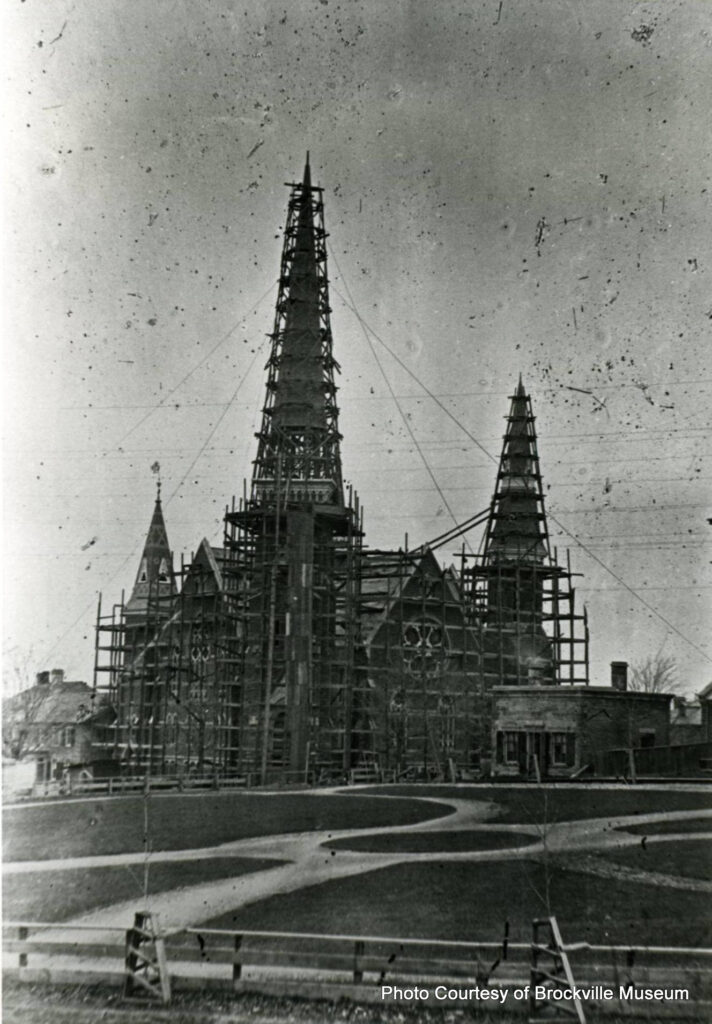

Municipal Address: 10 Church Street
Legal Description: Plan 67, Block 31 Part Lots 42 and 43
Designation Bylaw: 157-78 August 15, 1978
Architect: James P. Johnston
Designated for architectural reasons. It is a fine example of Gothic revival church architecture, built during the “High Victorian” period. Its unique character is derived from the use of four spires. The building’s prominent location adjacent to the Court House contributes to the streetscape of the district.
41 Cochrane Drive – ‘Beauvoir’, Isabella & George Easton House

Municipal Address: 41 Cochrane Drive
Legal Description: Block 2, Lot B
Designation Bylaw: 73-86
Architect: Unknown
Designated for architectural reasons.
Built in 1853, it is a rare example of Tudor Revival architecture in Brockville.
Court House Avenue – Isaac Brock Monument

Municipal Address: Court House Green
Legal Description: Lot 16, Block 31
Designation Bylaw: 166-79
Sculptor: Hamilton McCarthy
Designated for historical and architectural reasons. The monument is surrounded by a bust of General Sir Isaac Brock, a distinguished soldier who played a leading part in the defence of Upper Canada in the War of 1812. The City of Brockville is named for him. The monument is an attractive one in a prominent central location in the City.
Court House Avenue – John H. Fulford Fountain



Municipal Address: Court House Avenue
Legal Description: Lot 16, Block 31
Designation Bylaw: 165-79
Designed by: Herbert Raine A.R.C.A.
Designated for architectural and historical reasons.
It is an important addition to the streetscape of the main centre of the City. Designed by a competent architect and artist in memory of a former Mayor of the City, constructed of glazed terra cotta in the style of Italian Renaissance architecture, it was presented to the City on June 11th, 1917.
Court House Avenue – War Memorial



Municipal Address: Court House Avenue
Legal Description: Lot 17, Block 31
Designation Bylaw: 164-79
Sculptor: Nicholas Pirotton Figure was cast by the Allis Chalmers Co. of Toronto. The Memorial was built and erected by McIntosh Granite Co. of Toronto.
Designated for both historical and architectural reasons.
The monument was erected in 1924 in memory of those citizens of Brockville who died in the First World War. The granite base and shaft supports a bronze figure of a Canadian Infantryman in battle clothing grasping a rifle with fixed bayonet in his extended left arm while in the act of throwing a grenade with his right hand. The monument occupies a central position at the main crossroads of the City.
12/14 Court House Avenue – Post Office and Customs House
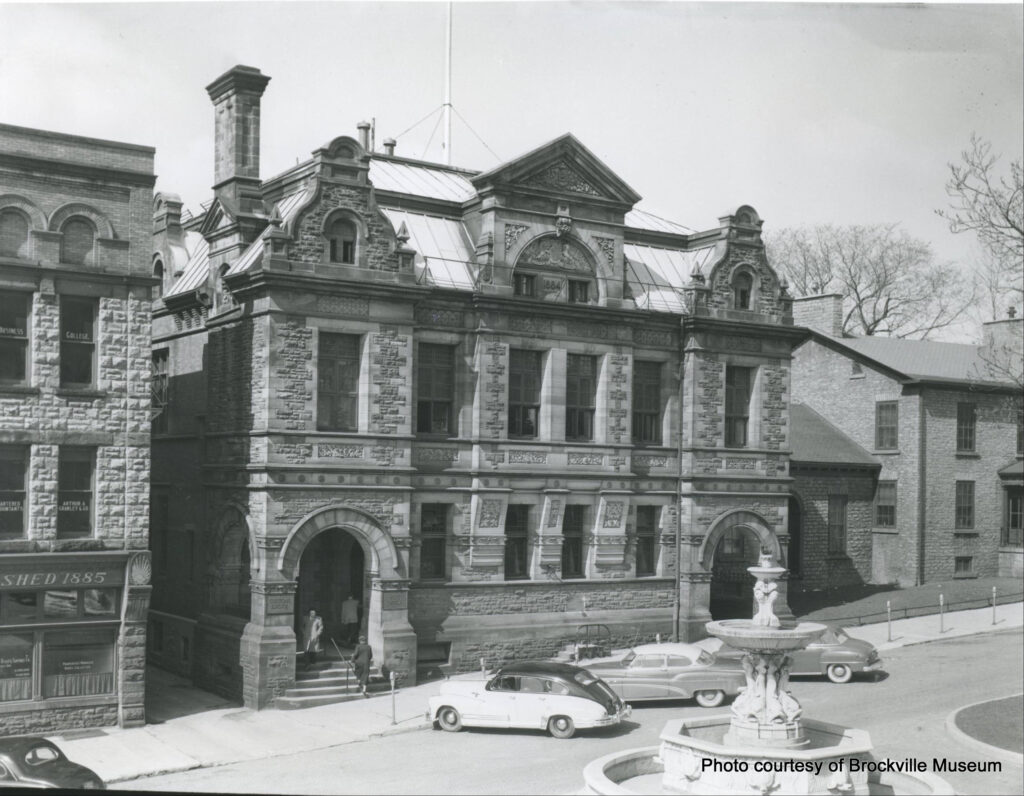
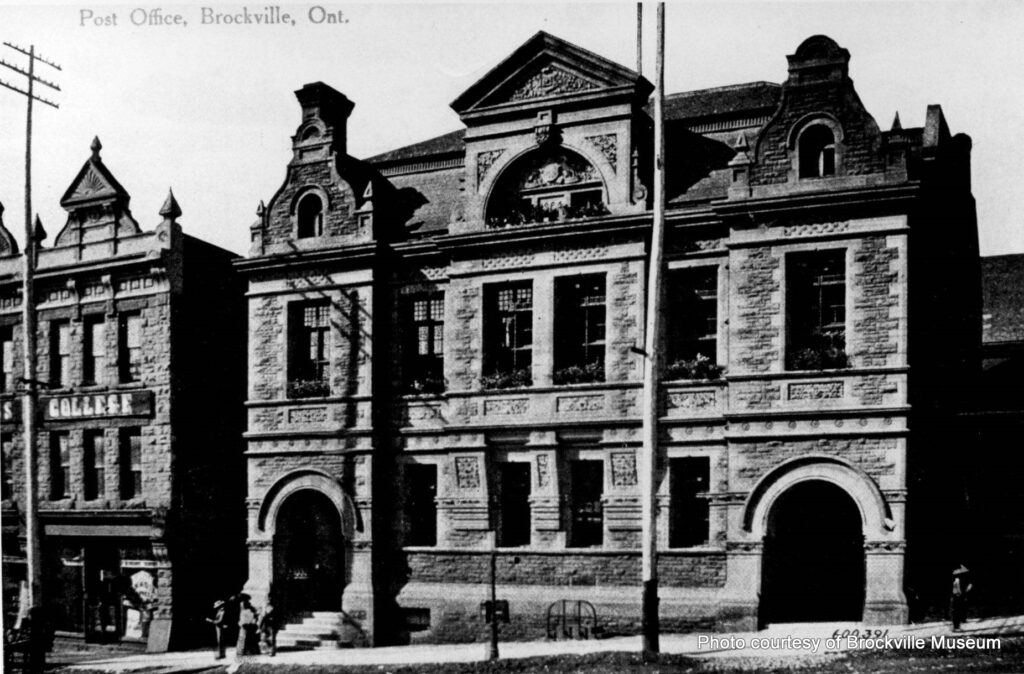
Municipal Address: 14 Court House Avenue
Legal Description: Plan 67, Block 31 Part Lot 37
Designation Bylaw: 311-79
Architect: Fuller, Thomas
Designated for both historical and architectural reasons.
The building has been a part of the Court House Avenue streetscape for over 94 years and served as the main post office and customs house for 77 of those years. It is an outstanding example from a series of public buildings built by the dominion government during the 1880s and was designed by the internationally-known architect, Thomas Fuller.
22 Court House Avenue – Elizabeth and Alexander Morris House

Municipal Address: 22 Court House Avenue
Legal Description: Plan 67, Block 31, Lot 36
Designation Bylaw: 312-79
Architect: Unknown
Designated for both historical and architectural reasons.
The building is a fine example of Loyalist neo-classical style, which was popular in the early nineteenth century, and is in an excellent state of preservation. Members of the Morris family were active participants in the early political and financial history of both Brockville and Canada.
50 Crawford Street – ‘Somerset’, Janet and Benjamin Chaffey House

Municipal Address: 50 Crawford Street
Legal Description: 1st Concession, Lot 7
Designation Bylaw: 60-85
Architect: Unknown
Designated for both historical and architectural reasons.
Victorian in style, the main house, stable, coach house wall and chapel have been an integral part of the streetscape since the 1860s and remain a constant reminder of its rich and distinguished history. The stone stable functions as a stable today. St. Alban’s Riding School, which operates on the premises, retains the name of the school brought to Brockville in 1906. The main house was occupied by Benjamin Chaffey, renowned civil engineer and contractor, from about 1859 to his death in 1867.
5 Henry Street – Aurinda and Isaac Beecher House



Municipal Address: 5 Henry Street
Legal Description: Block 30, Lot 50
Designation Bylaw: 155-78 August 15, 1978
Architect: Unknown
Designated for historical and architectural reasons. The house is a fine example of vernacular Loyalist stone construction, common in this area during the early 19th century. The well-preserved structure retains much of its original materials and workmanship. The Beecher family was influential in the early political and industrial history of the City. The building is now the home to the Brockville Museum.
40 King Street East – Robert Sheridan Store

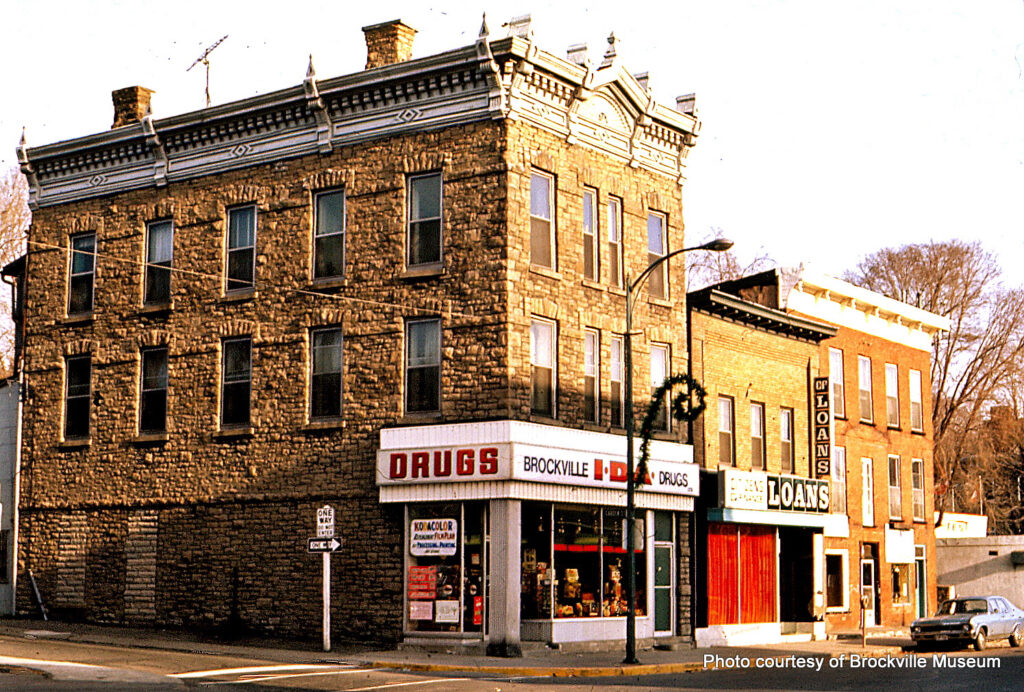
Municipal Address: 40 King Street East
Legal Description: Block 14, Lot 1
Designation Bylaw: 58-85
Architect: Unknown
Designated for both historical and architectural reasons.
The building is typical of the three-storey masonry commercial construction which stands on the main street of Brockville. Like many present King Street commercial properties it was solidly built in the late nineteenth century. A valuable feature is an elaborate sheet metal cornice on the two street elevations. During its life, the ground floor of the building has been occupied by a succession of businesses, representative of their period.
1 King Street West – Victoria Hall (now Brockville City Hall)



Municipal Address: 1 King Street West
Legal Description: Plan 67, Lot 8, Block 10
Designation Bylaw: 155-78
Architect: Unknown
Designated for architectural and historical reasons. Now used as the Brockville City Hall it was originally built during 1862-64 as a combination concert hall, office space, and indoor market house. It is an impressively designed stone building of strength and intricate detailing, with a clock tower of unusual beauty, sitting on a very significant central location.
41-45 King Street West – Jones- Harding Block

Municipal Address: 41-45 King Street West, 47 Broad Street
Legal Description: Block 29, Lot 8
Designation Bylaw: 209-87
Architect: Unknown
Designated for both historical and architectural reasons.
The structure is a striking example of commercial Georgian architecture on the prominent intersection of King and Broad Streets since 1882. During its life the ground floor of the building has been occupied by a succession of businesses, one of which may include Brockville’s first Post Office.
95-99 King Street West – Donaldson Block
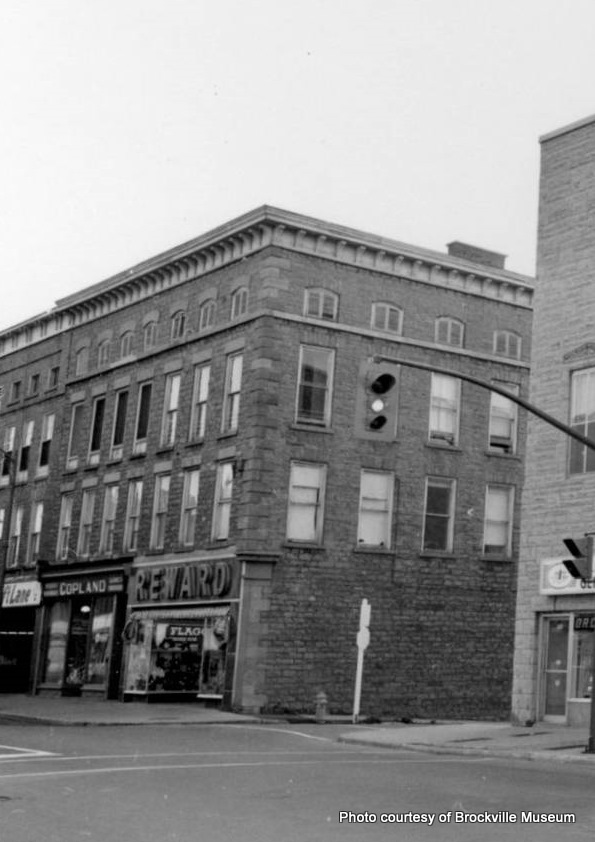
Municipal Address: 95-99 KIng Street West
Legal Description: Part Lots 34 & 35, Block 29
Designation Bylaw: 72-86
Architect: Unknown
Designated for both historical and architectural reasons.
The structure is a fine example of the type of mercantile architecture being constructed on Brockville’s main street during the mid-nineteenth century. It represents the movement from the construction of individual building units to larger commercial blocks.
301 North Augusta Road – Sarah & John Lawrence House

Municipal Address: 301 North Augusta Road
Legal Description: Part Lot 8, Concession 1
Designation Bylaw: 62-89
Architect: Unknown
Designated for architectural reasons. The stone and frame dwelling built ca.1860 is a fine example of the typical early rural centre gable farm house and it is one of the few within the confines of the present limits of the City of Brockville. The building is located on an oversize lot which enhances its visual character.
25 Pine Street – McNamara-Gardner House

Municipal Address: 25 Pine Street
Legal Description: Lot 6, Block 14, Plan 67
Designation Bylaw: 139-88
Architect: Unknown
Designated for architectural reasons.
This large brick house is asymmetrical and consists of two and a half storeys, the attic lying under a steep roof of varied style. The wood components of the facade are accented with intricate detailing on wide bargeboards, pediments and hood mouldings. The red brick is accented with contrasting coloured voussoirs connected to a soldier course marking the division of the first and second storey. This house has contributed to the surrounding streetscape since the mid-1880s.
17 Sherwood Street – Mary Ann & Robert Wright House

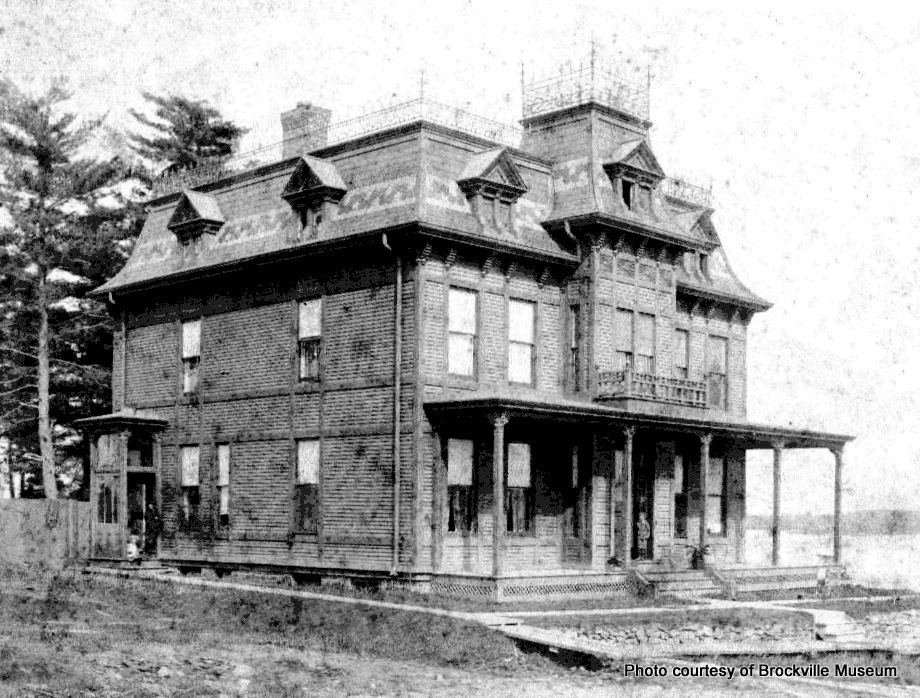
Municipal Address: 17 Sherwood Street
Legal Description: Part of lots 19, 20 and 21, Block 43
Designation Bylaw: 80-91
Architect: Unknown
Designated for architectural and historical reasons. This large and imposing house is a fine example of the Second Empire style and the only one of its kind in Brockville with a wooden, rather than brick, exterior. Most of the original features of that style are preserved.
The house stands as an example of a home built 110 years ago by a successful middle-class Brockville merchant, to be occupied for three generations of his family (Robert Wright) and as well by connections descended from Jonathan Buell, the original purchaser.
5 Wall Street – Wall St. United Church



Municipal Address: 5 Wall Street
Legal Description: Lots 61 and 62 and Part of Lots 60, 66 and 67 – Block 31
Designation Bylaw: 184-91
Architect(s): William Holmes, James P. Johnston, J.W. Powers
Designated for architectural, historical and contextual value or interest.
The church stands on grounds given by William Buell in 1831, on the condition that a church be erected on this land. On Saturday, February 14, 1830, the Wall Street Methodist Church was dedicated. The home of Paul and Barbara Heck became the birthplace of Methodism in Canada during the late 1700s. They settled in this district in 1785 and were among the first white inhabitants in the area. The building of Wall Street Church must have been influenced by their inspiration and therefore its historic significance and impact on the community helps to solidify the evolution of Brockville itself.
The large and dominant structure standing at the northeast corner of Court House Square is the result of a blending of six major construction stages which have occurred since the original church was erected in 1828-1830. Local quarry stone was used to construct the original church, as well as the subsequent additions, with the exception of the 1960 building on the northern addition known as Fellowship Hall.
58 Wall Street – Jane and Newton Cossitt House
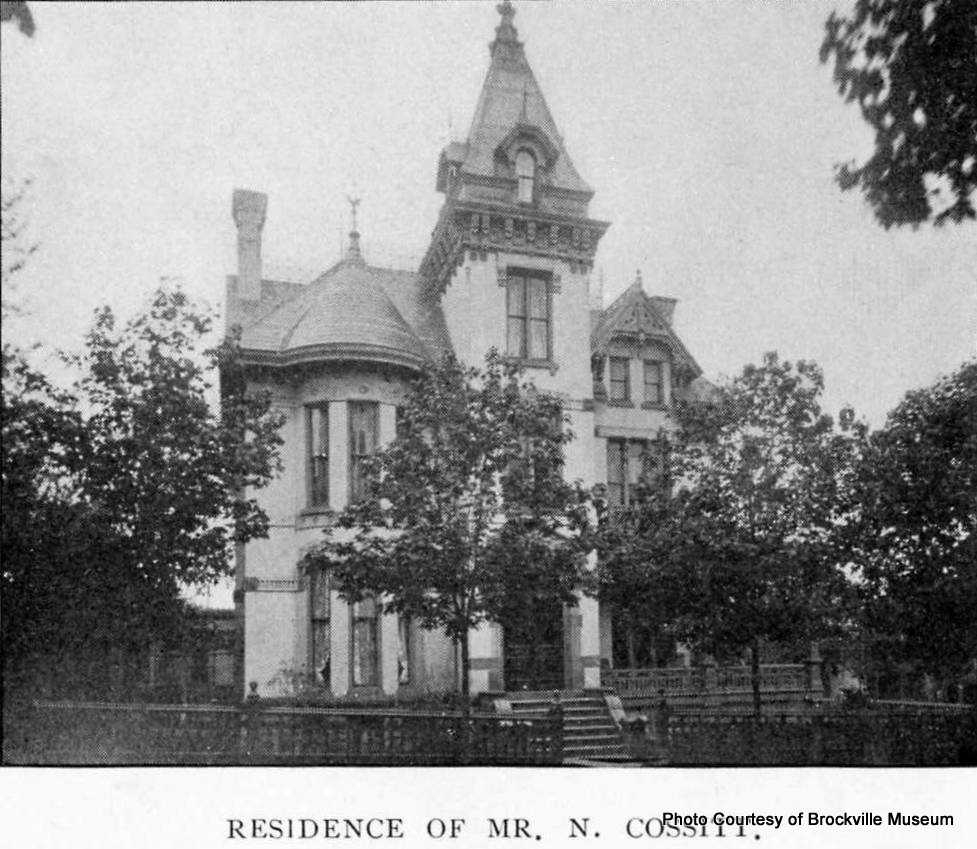
Municipal Address: 58 Wall Street
Legal Description: Plan 67, Block 32 Part Lot 15
Designation Bylaw: 158-78
Architect: James P. Johnston
Designated for architectural and historical reasons. Prominently, and centrally, located, it is an example of a recognized style of architecture popular in Ontario in the late nineteenth century. Its design is the work of an architect well-known in the district at the time. Its original owner was a member of a family which was then and still is prominent in local affairs.
123 Water Street West – Shepherd Grist Mill


Municipal Address: 123 Water Street West
Legal Description: Parts of Lot A, Block 30 and Part of Water Lot, Plan 67, comprised of Parts 1, 3, 4 and 5, Plan 28R 4092, Part 1 Plan 28R 2055 and Part 4 Plan 28R 4083
Designation Bylaw: 159-83
Architect: Unknown
Designated for both historical and architectural reasons. The mill site constitutes one of the oldest areas in Brockville, since early industry was located on the waterfront and Buell’s Creek. While other nineteenth century buildings remain in the area, Shepherd’s is the last mill building left in use from the nine that once utilized the power from Buell’s Creek.
Water Street & Pearl Street – Railway Tunnel




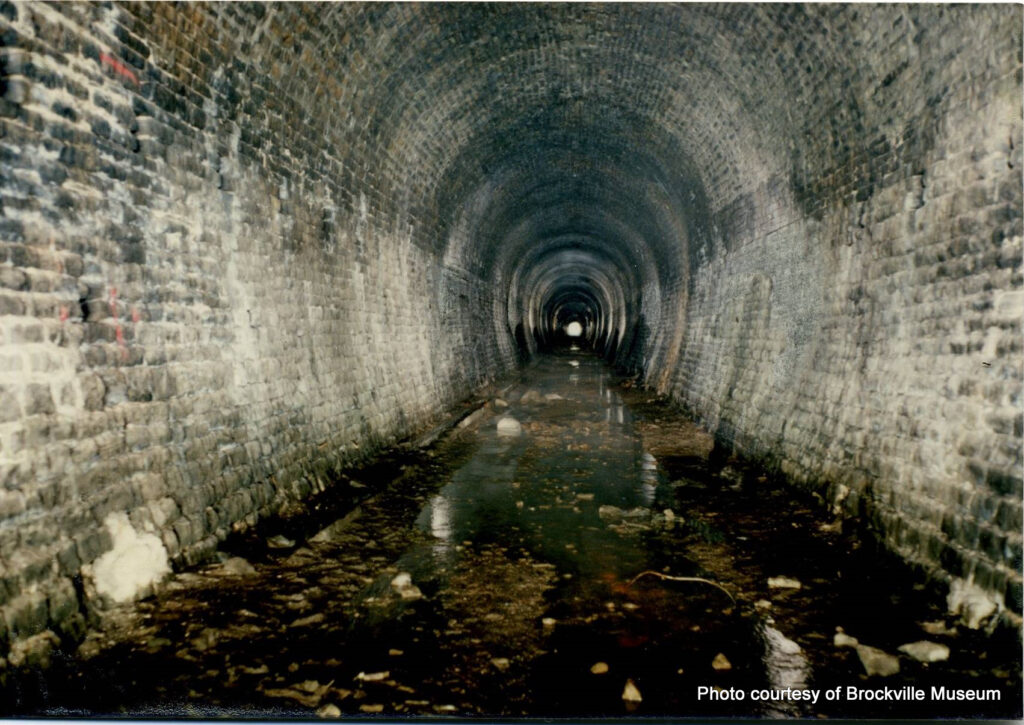


Municipal Address: Situated between Water Street and north of Pearl Street
Legal Description: Part of Market Square and Water Street, Block 29, Plan 67, designated Part 1 and part of Lot 11, Concession 1, City of Brockville
Designation Bylaw: 243-92
Designated for architectural and historical reasons. Started in 1854 and completed by 1860, it was Canada’s first railway tunnel. It formed a critical link in the Brockville and Ottawa Railway Co., and early railroad which was later absorbed by the CPR system. The construction of the tunnel had a great effect on the development of the Brockville waterfront both commercially and topographically. The tunnel, with its large wooden doors, forms a unique monument in Brockville, and is of distinct interest to both the citizens of the area and to visitors.
More information on the Brockville Railway Tunnel can be found on the Brockville Railway Tunnel website.
Brockville’s Listed Properties on the Municipal Register
Brockville’s Municipal Register of Cultural Heritage Properties includes properties that are Listed along with those that are Designated. Being Listed on the Heritage Register is not the same as having a property “Designated” under the Ontario Heritage Act. Listing a property is primarily an administrative process while designating a property is a legal process. Listed properties are properties that have been identified as having potential significant cultural heritage value, but have not gone through the process of designation.
Having a property listed on the Heritage Register is generally, and rightly so, a point of pride for property owners. Please click here to request a full listing of properties on the Heritage Register.

